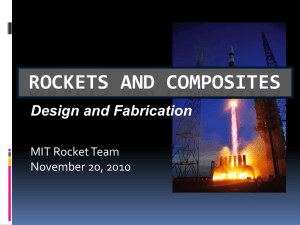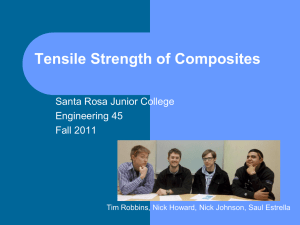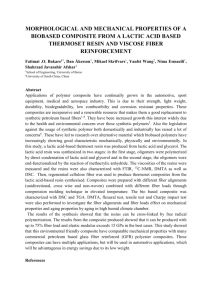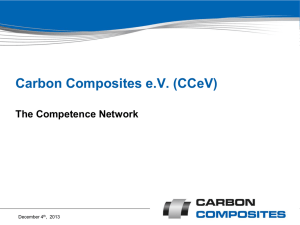Template - Research Script International Journals: IJRE
advertisement
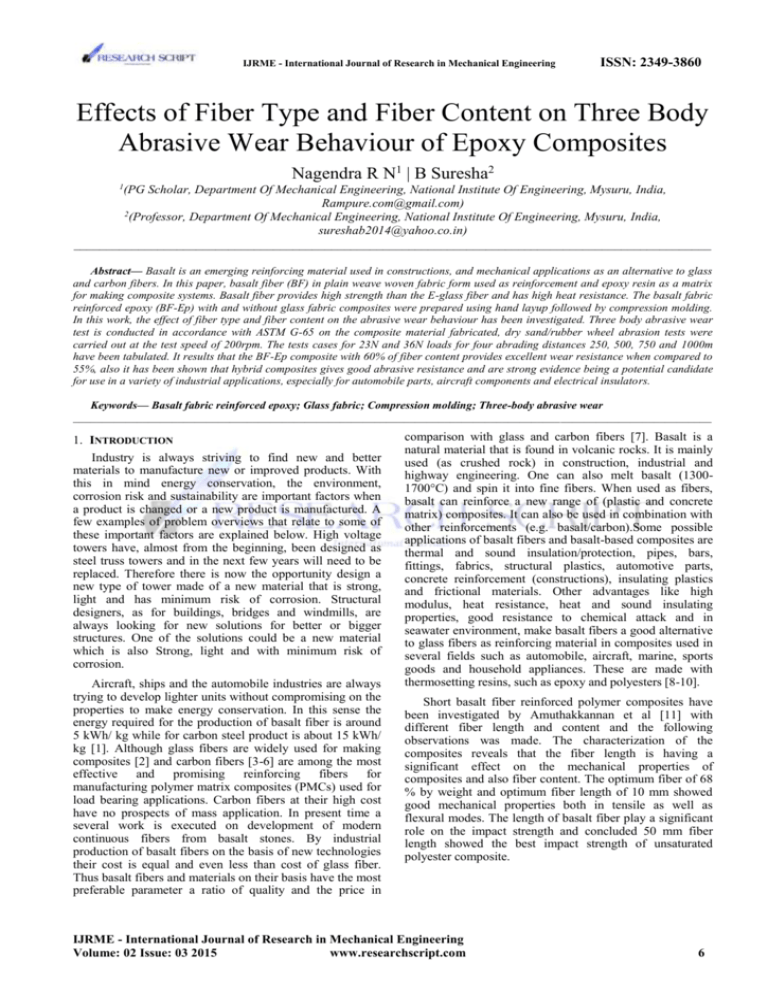
IJRME - International Journal of Research in Mechanical Engineering ISSN: 2349-3860 Effects of Fiber Type and Fiber Content on Three Body Abrasive Wear Behaviour of Epoxy Composites Nagendra R N1 | B Suresha2 1 (PG Scholar, Department Of Mechanical Engineering, National Institute Of Engineering, Mysuru, India, Rampure.com@gmail.com) 2 (Professor, Department Of Mechanical Engineering, National Institute Of Engineering, Mysuru, India, sureshab2014@yahoo.co.in) ___________________________________________________________________________________________________ Abstract— Basalt is an emerging reinforcing material used in constructions, and mechanical applications as an alternative to glass and carbon fibers. In this paper, basalt fiber (BF) in plain weave woven fabric form used as reinforcement and epoxy resin as a matrix for making composite systems. Basalt fiber provides high strength than the E-glass fiber and has high heat resistance. The basalt fabric reinforced epoxy (BF-Ep) with and without glass fabric composites were prepared using hand layup followed by compression molding. In this work, the effect of fiber type and fiber content on the abrasive wear behaviour has been investigated. Three body abrasive wear test is conducted in accordance with ASTM G-65 on the composite material fabricated, dry sand/rubber wheel abrasion tests were carried out at the test speed of 200rpm. The tests cases for 23N and 36N loads for four abrading distances 250, 500, 750 and 1000m have been tabulated. It results that the BF-Ep composite with 60% of fiber content provides excellent wear resistance when compared to 55%, also it has been shown that hybrid composites gives good abrasive resistance and are strong evidence being a potential candidate for use in a variety of industrial applications, especially for automobile parts, aircraft components and electrical insulators. Keywords— Basalt fabric reinforced epoxy; Glass fabric; Compression molding; Three-body abrasive wear ______________________________________________________________________________________________________________ 1. INTRODUCTION Industry is always striving to find new and better materials to manufacture new or improved products. With this in mind energy conservation, the environment, corrosion risk and sustainability are important factors when a product is changed or a new product is manufactured. A few examples of problem overviews that relate to some of these important factors are explained below. High voltage towers have, almost from the beginning, been designed as steel truss towers and in the next few years will need to be replaced. Therefore there is now the opportunity design a new type of tower made of a new material that is strong, light and has minimum risk of corrosion. Structural designers, as for buildings, bridges and windmills, are always looking for new solutions for better or bigger structures. One of the solutions could be a new material which is also Strong, light and with minimum risk of corrosion. Aircraft, ships and the automobile industries are always trying to develop lighter units without compromising on the properties to make energy conservation. In this sense the energy required for the production of basalt fiber is around 5 kWh/ kg while for carbon steel product is about 15 kWh/ kg [1]. Although glass fibers are widely used for making composites [2] and carbon fibers [3-6] are among the most effective and promising reinforcing fibers for manufacturing polymer matrix composites (PMCs) used for load bearing applications. Carbon fibers at their high cost have no prospects of mass application. In present time a several work is executed on development of modern continuous fibers from basalt stones. By industrial production of basalt fibers on the basis of new technologies their cost is equal and even less than cost of glass fiber. Thus basalt fibers and materials on their basis have the most preferable parameter a ratio of quality and the price in comparison with glass and carbon fibers [7]. Basalt is a natural material that is found in volcanic rocks. It is mainly used (as crushed rock) in construction, industrial and highway engineering. One can also melt basalt (13001700°C) and spin it into fine fibers. When used as fibers, basalt can reinforce a new range of (plastic and concrete matrix) composites. It can also be used in combination with other reinforcements (e.g. basalt/carbon).Some possible applications of basalt fibers and basalt-based composites are thermal and sound insulation/protection, pipes, bars, fittings, fabrics, structural plastics, automotive parts, concrete reinforcement (constructions), insulating plastics and frictional materials. Other advantages like high modulus, heat resistance, heat and sound insulating properties, good resistance to chemical attack and in seawater environment, make basalt fibers a good alternative to glass fibers as reinforcing material in composites used in several fields such as automobile, aircraft, marine, sports goods and household appliances. These are made with thermosetting resins, such as epoxy and polyesters [8-10]. Short basalt fiber reinforced polymer composites have been investigated by Amuthakkannan et al [11] with different fiber length and content and the following observations was made. The characterization of the composites reveals that the fiber length is having a significant effect on the mechanical properties of composites and also fiber content. The optimum fiber of 68 % by weight and optimum fiber length of 10 mm showed good mechanical properties both in tensile as well as flexural modes. The length of basalt fiber play a significant role on the impact strength and concluded 50 mm fiber length showed the best impact strength of unsaturated polyester composite. IJRME - International Journal of Research in Mechanical Engineering Volume: 02 Issue: 03 2015 www.researchscript.com 6 ISSN: 2349-3860 IJRME - International Journal of Research in Mechanical Engineering Matrix is used to bind the fibers and provide sufficient strength. Normally matrix includes resin and Hardener. Polyester resin tends to have yellowish tint, and is suitable for most backyard projects. Vinyl ester resin tends to have a purplish to bluish to greenish tint. This resin has lower viscosity than polyester resin, and is more transparent. This resin is often billed as being fuel resistant, but will melt in contact with gasoline. Epoxy resin is almost totally transparent when cured, they provide a unique balance of chemical and mechanical properties combined with wide processing versatility. In the aerospace industry, epoxy is used as a structural matrix material or as structural glue [12]. Bi-directionally hybrid composites of woven E-glass cloth/epoxy containing different amounts of silica were fabricated by Shivamurthy et al [13]. The three body abrasive wear testing were investigated under different loads and abrading distances the effect of silica content on wear loss and specific wear rate of the composites. For 3 wt. % silica-filled hybrid composite at an abrading distance of 300 m lowest wear rate was observed when compared to 6 and 9 wt. % silica filled composites and also on applied load at lower abrading distances the specific wear rate are strongly dependent in all composites. Amar Patnaik et al [14] studied on abrasive wear behaviour of randomly oriented glass fiber (RGF) reinforced with epoxy resin filled with Al2O3, Sic and pine bark dust. Dry sand/rubber wheel abrasion tests with 50N and 75N loads by varying the abrading distance were carried out. In RGF-epoxy composite filled with Sic filler, the lowest wear resistance was observed. It has been established in recent years that polymer based composites reinforced with continuous and bidirectional fiber can significantly improve the Tribological properties of the pure polymer matrix. Moreover, these improvements are achieved through conventional processing techniques without any detrimental effects on process ability, appearance, density and ageing performance of the matrix. In the present work plain weave bidirectional basalt fabric (BF) has been used as a load bearing material with 55 and 60 wt %. The epoxy resin was used to reinforce BF for preparation of BF-Epoxy composites. These composites characterized for their Tribological property. Three body abrasive wear testing of the specimen are conducted as per ASTM standard considering different fabricating parameters such as effect of fiber type and fibre content. used as matrix. For achieving homogeneous condition of the mixture the stirring process carried with the use of Stirrer. Then these resin mixture was used to fabricate the mixture of basalt and glass fibres in the compression moulding technique via roller. The samples are allowed to cure about 3 to 4 hours at room temperature. Similar procedure adapted for the preparation of the basalt and glass reinforced polymer composites. Table 1: Composition and designation of fiber reinforced composite samples Composition Composite designation Basalt Glass epoxy BF1-EP 55 - 45 BF2-EP 60 - 40 BF+GF-EP 25 25 50 B. Three-Body Abrasive Wear Tests The three-body abrasive wear tests were conducted using a dry sand/rubber wheel abrasion tester as per ASTM G-65 [15]. The schematic representation of rubber wheel test set up was shown in Fig-1. In the present study, silica sand (density 2.6 g/cm3) was used as the abrasive. The sample was cleaned with acetone, dried and its initial weight was noted in a high precision digital balance before it was mounted in the sample holder. At the end of the test, the sample was removed, thoroughly cleaned and again the final weight determined. The difference in weight calculated is a measure of abrasive wear loss. The experiments were carried out at two different loads (23 and 36 N) under different abrading distances (250 m to 1000 m). The wear was measured by the loss in weight, which was then converted into wear volume using the measured density data. The specific wear rate (Ks) was calculated from the equation. 2. MATERIALS AND METHODS A. Materials In this work, plain weave type basalt fibre is used which is produced by so-called Junkers technology and commercially available E-Glass fibre is used as reinforcements and as matrix material Epoxy resin is used. Where Ks is the specific wear rate in mm3/Nm, V is the volume loss in m3, L is the load in N and D is the abrading distance in m. The basalt fibre reinforced and basalt/ glass fibre reinforced polymer matrix composites were fabricated using compression moulding method. General epoxy resin was IJRME - International Journal of Research in Mechanical Engineering Volume: 02 Issue: 03 2015 www.researchscript.com 7 ISSN: 2349-3860 IJRME - International Journal of Research in Mechanical Engineering Table 2: Basalt epoxy with 55 wt% results for the three body abrasion test SL No. Abrading distance (m) Weight loss (gm.) Volume loss (mm3) Specific wear rate mm3/Nm 1a 250 0.296 152.5 0.0265 2a 500 0.320 164.9 0.0143 3b 750 0.370 190.72 0.0110 4b 1000 0.508 261.8 0.0113 Figure 1: Three-body abrasive wear Specimens after testing Table 3: Basalt epoxy with 60 wt% results for the three body abrasion test SL No. Abrading distance (m) Weight loss (gm.) Volume loss (mm3) Specific wear rate mm3/Nm 1a 250 0.216 109.6 0.0190 2a 500 0.304 154.3 0.0134 3b 750 0.320 162.4 0.0094 4b 1000 0.408 207.1 0.0090 Table 4: Basalt/glass epoxy with 25+25 wt% results for the three body abrasion test Figure 2: Three body abrasive wear setup 3. RESULTS AND DISCUSSIONS This chapter represents and describes the experimental results for 55% and 60% BF with epoxy, and 25%+25%+50% of Basalt/glass fiber with epoxy respectively. This session also includes evaluation of Tribological properties. The equipments used and the standard guidelines followed for conducting the experiments are explained in details in previous chapter. The results obtained are the values taken after testing specimens of each composition. A. Three body Abrasive wear test Trail 1: Load = 23 N Speed = 200rpm SL No. Abrading distance (m) Weight loss (gm.) Volume loss (mm3) Specific wear rate mm3/Nm 1a 250 0.089 44.5 7.739×10-3 2a 500 0.158 79 6.869×10-3 3b 750 0.196 98 5.68×10-3 4b 1000 0.208 104 4.521×10-3 Abrasive = Sand IJRME - International Journal of Research in Mechanical Engineering Volume: 02 Issue: 03 2015 www.researchscript.com 8 ISSN: 2349-3860 IJRME - International Journal of Research in Mechanical Engineering 300 250 3 Volume loss (mm ) Table 6: Basalt epoxy with 60 wt% results for the three body abrasion test BF1-Ep BF2-Ep BF+GF-Ep SL No. Abrading distance (m) Weight loss (gm.) Volume loss (mm3) Specific wear rate mm3/Nm 1a 250 0.404 205 0.0227 2a 500 0.508 257.8 0.0147 3b 750 0.534 271 0.0100 4b 1000 0.596 302.5 0.0084 200 150 100 50 200 300 400 500 600 700 800 900 1000 1100 Abrading distance (m) (a) BF1-Ep BF2-Ep BF+GF-Ep SL No. Abrading distance (m) Weight loss (gm.) Volume loss (mm3) Specific wear rate mm3/Nm 1a 250 0.237 118.5 0.0131 2a 500 0.276 138 7.66×10-3 3b 750 0.315 157.5 5.83×10-3 4b 1000 0.355 177.5 4.93×10-3 0.020 3 Specific wear rate (mm /Nm) 0.025 Table 7: Basalt/glass epoxy with 25+25 wt% results for the three body abrasion test 0.015 0.010 0.005 0.000 200 400 600 800 1000 Abrading distance (m) (b) Figure 3: (a) volume loss V/s abrading distance and (b) Specific wear rate V/s abrading distance for different samples at 23N BF1-Ep BF2-Ep BF+GF-Ep 400 Trail 2: Load = 36 N Speed = 200rpm 350 SL No. Abrading distance (m) Weight loss (gm.) Volume loss (mm3) Specific wear rate mm3/Nm 1a 250 0.475 244.8 0.0272 2a 500 0.555 286.0 0.0158 3b 750 0.601 309.7 0.0114 4b 1000 0.764 393.8 0.0109 3 Table 5: Basalt epoxy with 55 wt% results for the three body abrasion test Volume loss (mm ) Abrasive = Sand 300 250 200 150 100 200 300 400 500 600 700 800 900 1000 1100 Abrading distance (m) IJRME - International Journal of Research in Mechanical Engineering Volume: 02 Issue: 03 2015 www.researchscript.com (a) 9 IJRME - International Journal of Research in Mechanical Engineering BF1-Ep BF2-Ep BF+GF-Ep 0.020 3 Specific wear rate (mm /Nm) 0.025 0.015 ISSN: 2349-3860 specific wear resistance was noticed for hybrid composite due to high strength and hardness of glass fiber. From the above conclusions we can see that Tribological properties increases when basalt content increases, also when we hybridize basalt with glass in epoxy in the ratio of 25:25:50 hoping to produce an economically sound composite since basalt fabric prices are costlier than glass we found that by hybridizing basalt reinforcement with glass we are increasing the brittle nature of the composite. REFERENCES 0.010 [1] 0.005 [2] 0.000 200 400 600 800 1000 Abrading distance (m) (b) [3] [4] Figure 4: (a) volume loss V/s abrading distance and (b) Specific wear rate V/s abrading distance for different samples at 36N Fig (3 & 4) shows the wear volume and specific wear rate as a function of abrading distance for BF composites having 55wt%, 60wt% and BF+GF composites for different loads. The wear data reveal that the wear volume tends to increase linearly with increasing abrading distance and strongly depends on the applied load for all the composites tested. It was observed that the wear performance is improved for BF2-Ep composite due to higher fiber content. The variations in the specific wear rate with abrading distance at 23 and 36N loads are shown in above Fig 3b & 4b, respectively. The specific wear rate decreases with increasing abrading distance but increases with increase in applied load. The results revealed higher abrading nature of BF2-Ep composite compared to BF1-Ep specimen and also it has been shown that hybrid composites gives good abrasive resistance when compared to other ratio of the composites. The phenomenon of decrease in specific wear rate is due to the nature of micro particles used. 4. CONCLUSION 1. Specific wear rate increased with applied load at lower abrading distance and decreased with increasing abrading distance. BF2-Ep composite showed better abrasion resistance as compared to that of BF1-Ep composites. 2. Basalt/Glass fibers in epoxy matrix showed less wear out. This result revealed better interfacial adhesion between basalt with glass fibers and epoxy as compared to the adhesion between basalt fibers and epoxy. [5] [6] [7] [8] [9] [10] [11] [12] [13] [14] [15] Eythor Thorhallsson, Jon olafur Erlendsson and Ogmundur Erlendsson, “Basalt fiber introduction” eykjavik University & Iceland GeoSurvey November 2013. Mishra, “Studies on mechanical performance of Bio fibre/glass reinforced polyester hybrid composites ”Composites Science and Technology 63.10 (2003), pp.no:1377-1385. Hughes, J.D.H, "The carbon fibre/epoxy interface a review." Composites Science and Technology 41.1 (1991): 13-45. Meier, Urs."Strengthening of structures using carbon fibre/epoxy composites” Construction and Building Materials 9.6 (1995): 341351. G.Williams, R.Trask, I.Bond, “A self-healing carbon Fiber reinforced polymer for aerospace applications”, Composites: Part A 38 (2007) 1525–1532. Prashanth Turla, S.Sampath Kumar, P.Harshitha reddy, K.Chandra Shekar, “Processing and Flexural Strength of Carbon Fiber and Glass Fiber Reinforced Epoxy-Matrix Hybrid Composite” IJERT Vol. 3 Issue 4, April 2014. Kunal singha,“A short review on basalt fiber,” International Journal of textile science 2012, 1(4): 19-28. Vivek Dhand, Garima Mittal, KyongYop Rhee, SooJin Park, David Hui, “A short review on basalt fiber Reinforced polymer composites” Composites: Part B 73 (2015) 166–180. Van de Velde K, Kiekens P, Van Langenhove L.Basalt fibres as reinforcement for composites. In: Proceedings of 10th international conference on composites/ nano engineering,New Orleans, LA, USA; 20–26 July 2003. V.Fiore, T.Scalici, G.Di Bella , A.Valenza, “A review on basalt fibre and its composites”, composites Part B 74 (2015) 74-94 P.Amuthakkannan, V.Manikandan, J.T,Winowlin Jappes, M.Uthayakumar, “Effect of fiber length and Fiber content mechanical properties of short basalt fiber reinforced polymer matrix composites,” material physics and mechanics 16 (2013) 107117 Received: January 9, 2013 C.Colombo, L.Veragani, M.Burman, “Static and fatigue characterisation of new basalt fiber reinforced composites”, Composite Structures 94 (2012) 1165–1174 B.Shivamurthy, S.Anandhan and K.Udaya Bhat, “Epoxy/Glass Fabric/Silica Hybrid Composites: Mechanical Properties and Wear Behavior”,Advanced Science, Engineering and Medicine Vol. 5, 2013 Amar Patnaik, Alok Satapathy, Sandhyarani Biswas, “Investigations on Three-Body Abrasive Wear and Mechanical Properties of particulate filled glass epoxy Composites”, Malaysian Polymer journal, Vol. 5 2010 ASTM D 65-00, Standard Test Methods for Measuring Abrasion using the Dry Sand/Rubber Wheel Apparatus, ASTM International, West Conshohocken, PA, 2000 3. The wear volume was less in the composite material with 60% as compared to that of 55% fiber content. Higher IJRME - International Journal of Research in Mechanical Engineering Volume: 02 Issue: 03 2015 www.researchscript.com 10
